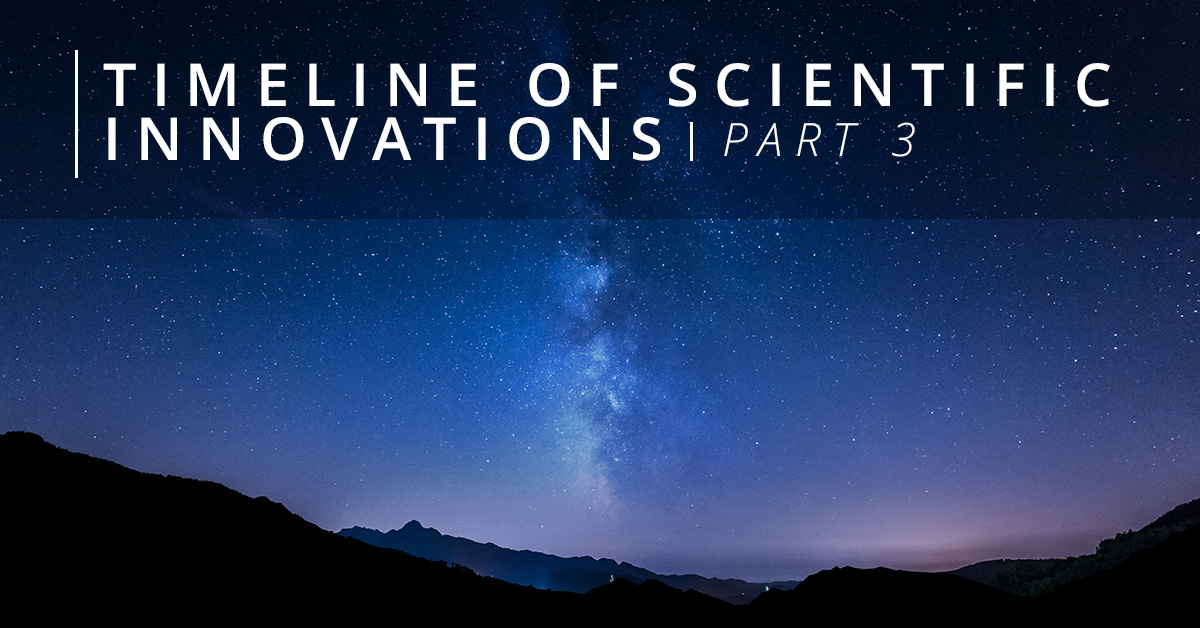
Here at Flex Technologies, we are proud to be on the cutting edge of silicone tube manufacturing and silicone hose manufacturing. Luckily, we are able to stand on the shoulders of giants with our innovations, making use of countless discoveries our ancestors made before us for more complicated, useful future innovations. To celebrate the history of scientific discovery that we draw upon with each new step towards progress, we would like to finish our 3 part series of the timeline of scientific innovations. Here, we will cover scientific innovation in the 19th and 20th centuries, after the technology boom had already begun.
19th Century
By the 19th century, steam power caused an explosion in the shipping and railway industries. This allowed for more production, greater wealth in the population, more leisure time, and thus even more innovation. Here are just some of the scientific innovations of the time.
- At the beginning of the 19th century, in 1805, John Dalton would create and popularize the Atomic Theory in chemistry. The Atomic Theory merely states that all matter is made of discrete parts called atoms. While precursors to this theory existed in Ancient Greece, it was only in the 19th century that scientific proofs were offered.
- 15 years later, Hans Christian Orsted would discover the principle of electromagnetism when he noticed that a current that is passed through a wire will cause a compass' needle to deflect. Electromagnetism refers to the interaction between electric currents and fields and magnetic fields.
- 6 years later, in 1821, Thomas Johann Seeback would be the first person to observe the properties of semiconductors. Most of our modern gadgets rely on our semi conductors in one form or another, which just goes to show you how breaking even one link in the chain could be disastrous for scientific progress.
- Georg Ohm would establish Ohm's law in 1827, the same year that Amedeo Avogadro came up with Avogradro's law. Ohm's law states that the electrical current between two points is in direct proportion to the voltage across those same two points. Avogradro's law, or the Gas law, states that at the same volume, temperature, and pressure, two gases will have the same number of molecules.
- Mathematics saw major progress in 1830 when Nikolai Lobachevsky created what we know as Non-Euclidean geometry. While the basics of Non Euclidean geometry had been laid out before, it had never been codified and tested in mathematics.
- Michael Faraday, creator of the Faraday cage, would discover the principles of electromagnetic induction that allowed him to create the invention in 1831. A Faraday cage protects an area from conducting an electric field, so electric currents (like a lightning strike) would pass around the area.
- In 1833, a huge breakthrough in chemistry was achieved by Anselme Payen, who first isolated an enzyme. This first isolated enzyme, or chemical reaction catalyst, was diastase.
- In 1842, scientist Christian Doppler first noticed, named, and popularized the Doppler effect. The Doppler effect refers to how an observer views a change in frequency or wavelength as it moves closer or further away. With sound, for instance, when you hear a police siren getting higher in pitch as it approaches, that is the Doppler effect. There is a Doppler effect with light too, where a source of light that is moving toward a viewer will appear blue, while a source of light moving away from the viewer will appear red.
- In 1843 and 1847 two huge physics breakthroughs happened independent of one another. In 1843, James Prescott Joule first propositioned the First Law of Thermodynamics, or Law of Conservation of Energy, wherein energy could not be created or destroyed. In 1847, Helmholtz also independently came to the same principle, and started to promote it himself.
- In 1848, Lord Kelvin of the famed Kelvin temperature measurement discovered the concept of absolute zero. Absolute zero is the lower limit of the thermodynamic temperature scale, where molecules are so cold they essentially stop moving except on a quantum level.
- In 1859, Charles Darwin came up with and promoted the theory of evolution alongside Alfred Wallace. They argued that natural selection was responsible for the traits of living organisms.
- In 1861, a huge breakthrough in medicine was made when Louis Pasteur created Germ theory. Finally, there was an understood cause for illnesses, and doctors could effectively stop their spreading if not treat the illness itself.
- Marie Curie, a lauded female scientist, was the first to discover polonium and radium, two radioactive chemicals. In fact, she was the first person to ever coin the term "radioactive".
20th Century
The previous century saw more technological progress than ever before. In fact, looking back at human history, it would seem that technology increases exponentially. There's no way we could include even close to all of the scientific innovations of the time, so here are some of the major ones.
- Albert Einstein invents special relativity to revolutionize modern physics as we know it. His work on special relativity was absolutely necessary for satellite technology, the atomic bomb, and nuclear power, just to name a few technologies that could not exist without him.
- In 1913, famous physician Niels Bohr, who made great strides in quantum mechanics, made the first ever model of the atom. It showed the atom as a tiny, positively charged nucleus, surrounded by negatively charged electrons traveling in circular orbits. It is similar to the makeup of the solar system, except with electrostatic forces moving everything instead of gravity.
- Karl Schwarzschild would discover the Schwarzschild radius in 1915, which led to the identification of black holes by Steven Hawking.
- A huge medical breakthrough happened in 1922, when doctors Charles Best, James Collip, Frederick Bantin, and John Macleod isolated and produced insulin. Nowadays, millions of diabetics around the world rely on this medicine in their day to day lives.
- Georges Lemaitre reinvented our modern cosmology in 1927 when he came up with his theory of the Big Bang. This theory explains the origin of our universe as essentially the explosion from a huge, solid mass similar to a black hole (but containing the mass of the entire universe).
This finishes our three part series of the timeline of scientific innovation. There is sure to be lots we left off, so feel free to find out others on your own. Here at Flex Technologies, we are proud to follow in the footsteps of such innovators by constantly honing our silicone tube and silicone hose manufacturing processes. If you would like to order some of our silicone hoses and tubes online, please do not hesitate to check out our wares. Give us a call for more information.
 Default Currency
Default Currency
 Mexican Pesos
Mexican Pesos
 Canadian Dollar
Canadian Dollar


